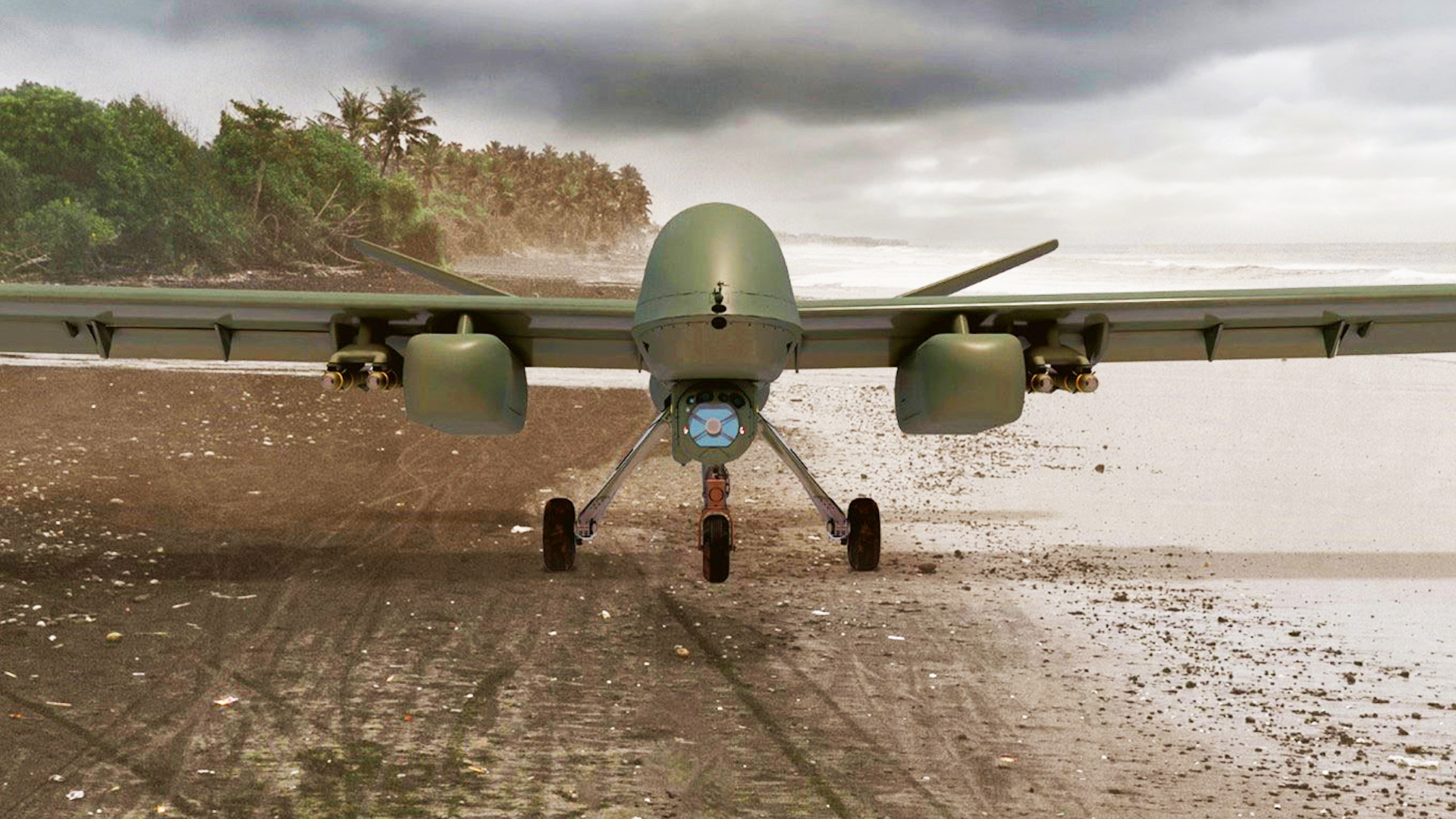General Atomics Aeronautical Systems (GA-ASI) has provided details on the latest iteration of its MQ-1C Gray Eagle uncrewed aerial system (UAS), specifically the Gray Eagle STOL, or Short Takeoff and Landing variant. The new version of the drone incorporates technology that was first demonstrated on the company-funded Mojave, a heavily armed drone descended from the Gray Eagle that was also designed to be ideally suited to operating from remote or austere locations with rough strips and limited logistical support. The new drone is also very clearly pitched toward the U.S. Army and foreign customers that need increase distributed operations — as evidenced in the concept art at the top of this story — dispersed operations in the Pacific specifically.
GA-ASI describes the Gray Eagle STOL as its “most rugged UAS design,” although it’s worth noting at this point that the basic MQ-1C Gray Eagle for the U.S. Army was already something of a design that put a premium on efficiency and usability. Derived from the Air Force’s Predator, the Gray Eagle — originally known as the Warrior — was tailored for warfare in the Middle East, used a heavy-fuel piston engine instead of a turboprop, and was intended to be operated by a cadre of enlisted soldiers.

Further reducing the footprint in terms of logistics and crews, the MQ-1C was designed to take off and land automatically through secure line-of-sight links, before flying beyond-line-of-sight missions via satellite communications.
Enhancements for the MQ-1C soon followed, including an extended-range model with double the range and endurance, a test example staying aloft for nearly two days nonstop in a demonstration above Southern California.
Building upon the MQ-1C Gray Eagle, GA-ASI is now offering the Gray Eagle STOL, which emphasizes the ability to operate from unimproved surfaces or even ships at sea, thanks to its short takeoff and landing capability, which was previously proven using the Mojave, first flown in 2021.
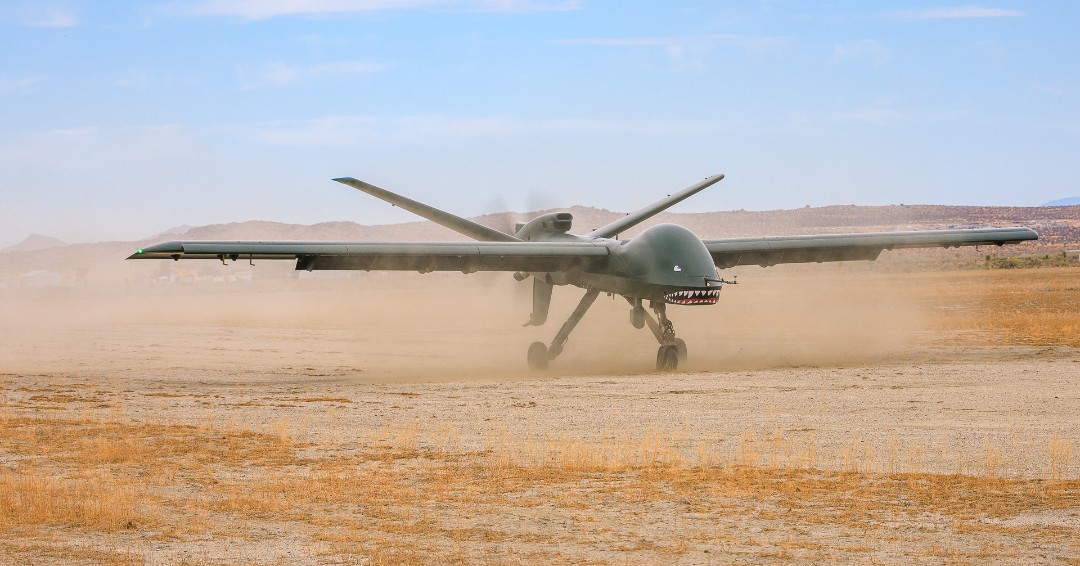
Using the Gray Eagle STOL, “commanders can choose virtually any bases of operation and take advantage of unconventional locations not normally affiliated with unmanned aircraft or aviation operations as an added level of survivability and surprise,” GA-ASI asserts.
The Mojave’s ability to take off and land in very short distances — including on dirt strips — is something we have reported on before. Its stated performance includes a takeoff run of 400 feet for intelligence, surveillance, and reconnaissance (ISR) missions, or 1,000 feet when armed with 12 Hellfire missiles. Other weapons options include the Dillon Aero DAP-6 Minigun, which has been live-fire tested from the Mojave at Army’s Yuma Proving Ground.

Its STOL attributes also lend the Mojave to shipborne operations, as demonstrated during trials aboard the British aircraft carrier HMS Prince of Wales. The short-field performance is such that the Mojave can also conduct carrier-based operations, in certain configurations, without any need for a catapult to launch it or arresting gear during recovery.

This STOL performance has now been ported over to the Gray Eagle STOL, as C. Mark Brinkley, a General Atomics spokesman, described to TWZ.
“Mojave is simply a demonstrator model for our overall STOL concept, meant to show the possibilities afforded by our medium-altitude, long-endurance UAS when STOL capability is added. It’s one-of-a-kind and was not designed to go into production as it is currently built. We continue to use it as a technology demonstrator and have some upcoming demos scheduled, as well as some public showings planned at various trade shows next year.”
With that in mind, the Gray Eagle STOL also adds some features that were not found on the Mojave.
These include the various technologies introduced on another improved development of the MQ-1C, namely the Gray Eagle 25M (or GE 25M), first flown in December 2023.
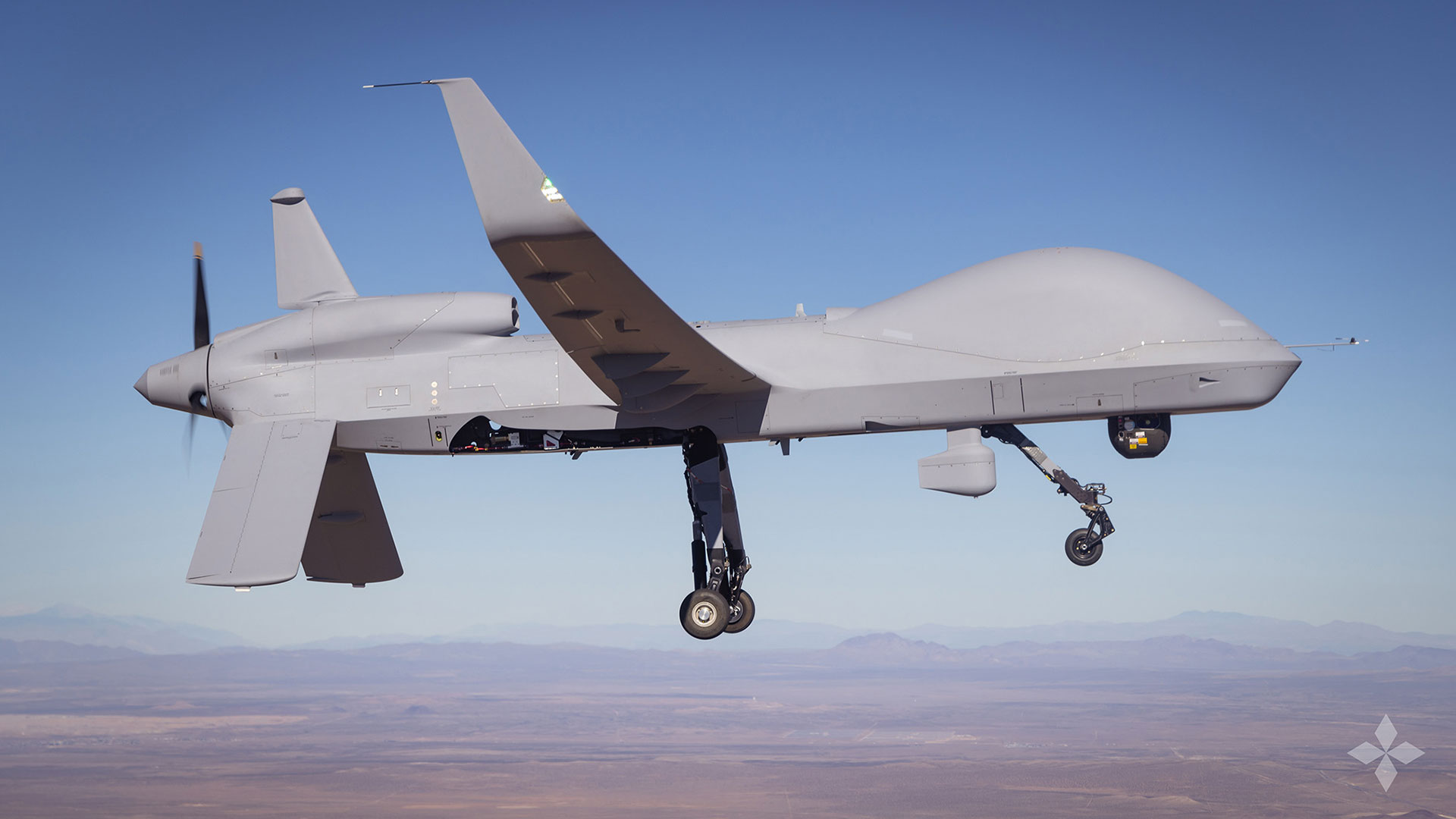
The Gray Eagle 25M was developed to provide the U.S. Army with the option to procure a more advanced version of the MQ-1C, which would incorporate various enhancements to better meet the demands of a future conflict, likely to be expeditionary peer conflicts rather than a counterinsurgency fight.
Among these new features are an improved heavy-fuel engine, increased onboard power, significantly reduced maintenance requirements, and an expeditionary laptop-based ground control station.
Brinkley says the new Heavy Fuel Engine 2.0 “increases reliability, durability and horsepower, from 180 to 200 horsepower. It features dual brushless generators, which will dramatically reduce field maintenance and deliver over 50 percent more electrical power for new payloads and mission capabilities. The new engine, gearbox, and generator design decreases major maintenance actions and virtually eliminates the need for overhaul. The design effort was focused on reducing field maintenance and extending the time between engine replacement by 40 percent over the current Gray Eagle engine.”
The Gray Eagle 25M also has an improved flight computer, with five times more processing capacity, and a modular open system architecture to ensure new capabilities can be integrated quickly and relatively cheaply. According to GA-ASI, these might include new air-launched effects and long-range sensors.
In fact, the manufacturer is making a lot of the Gray Eagle 25M’s ability to work with air-launched effects. In one press release, GA-ASI lays out a scenario in which the Gray Eagle 25M lobs air-launched effects toward enemy air defense systems in a large and very contested battlefield. As the air-launched effects close in on the air defenses, the Gray Eagle 25M acts as “quarterback,” relaying data gathered by the smaller drones to other friendly elements, be they aircraft, long-range fires, or other platforms.
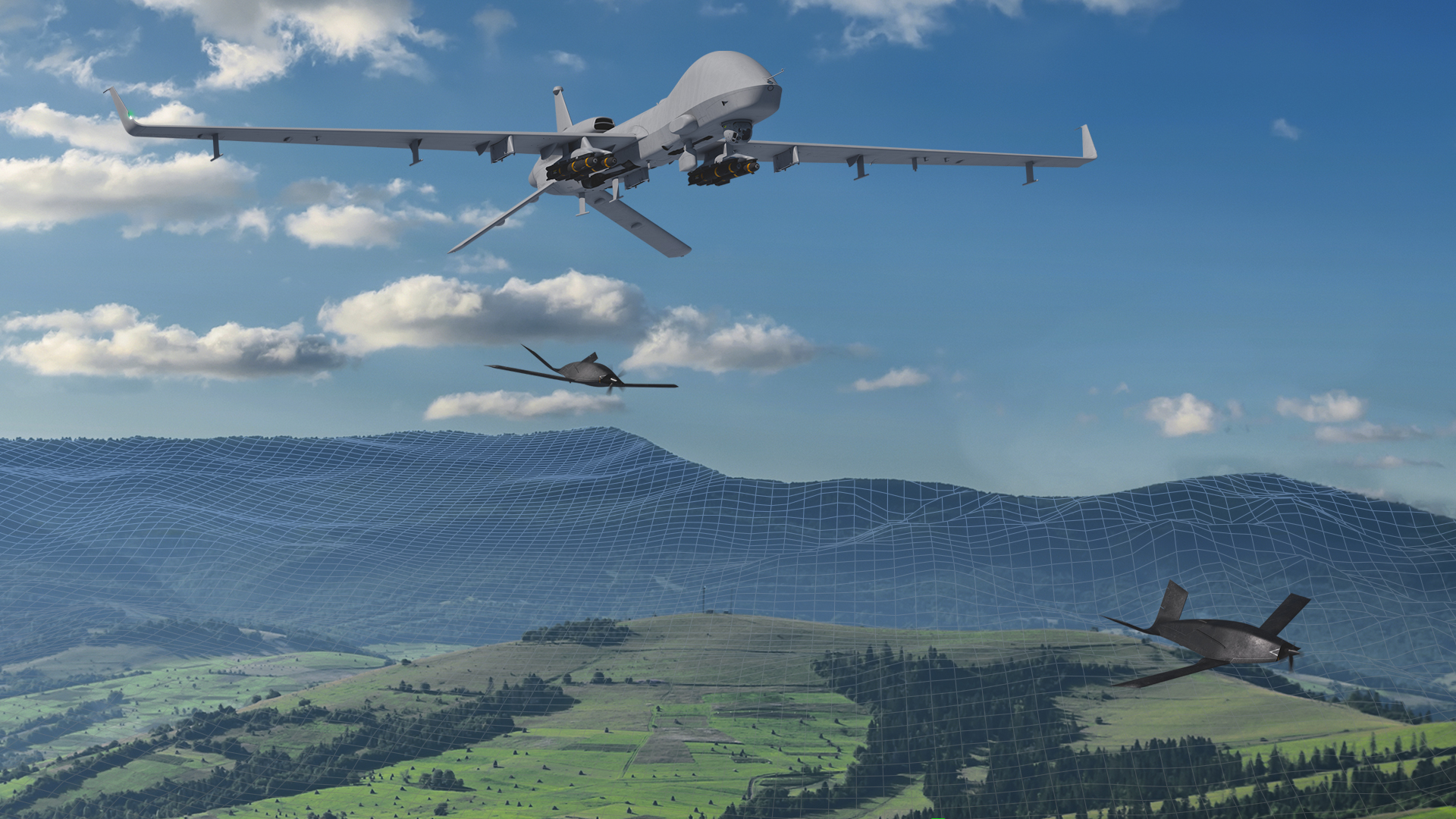
The Gray Eagle 25M is fitted as standard with the EagleEye synthetic aperture radar, which can detect and track ground targets out to 50 miles and maritime targets out to 124 miles.
“We are developing a new Active Electronically Scanned Array (AESA) antenna and associated software for EagleEye, which will further increase its range and deliver significant mode enhancements, Brinkley says. “The radar’s increased range and optimized multi-mode performance will allow the aircraft to operate well outside the weapons effects zone of most threat systems, adding another layer of survivability.”
Reflecting the increasing threat posed by hostile electronic warfare jamming, especially to GPS networks, the Gray Eagle 25M is also designed for greater resilience, including vision-based navigation that can be used to overcome GPS jamming, and SATCOM anti-jam technologies.
GA-ASI says that all of the improvements found in the Gray Eagle 25M are now also incorporated in the Gray Eagle STOL. However, with different engines, wings, and tails, the Gray Eagle 25M and Gray Eagle STOL are very different aircraft, and the STOL version is not available as a conversion kit for GE 25M.
The end result is a drone that combines advanced features with the ability to fly a wide variety of missions, from land and sea. At the forefront of the expected spectrum of missions are expeditionary ones of the kind that would be likely in any future high-end conflict, such as one in the Pacific against China.
The Gray Eagle STOL is being pitched for reconnaissance, surveillance, and target acquisition (RSTA), as well as attack, contested logistics, and other missions, in just such scenarios.
Logistics is not a role that has traditionally been associated with drones of this kind. However, GA-ASI has explored the idea of underwing pods capable of carrying up to 1,000 pounds of cargo. The U.S. military sees diverse distributed logistics chains as increasingly essential for supporting future operations in contested environments, especially in the context of a potential future high-end conflict, including in the Pacific.

As GA-ASI describes it: “Gray Eagle STOL might go with American forces into an expeditionary base deep downrange, co-locating with them as necessary to support missions, including delivery of supplies with the range to reach from island chain to island chain for units separate from the main body. Operating from a semi-prepared landing zone, a dirt road, or any paved surface, it expands commanders’ options.”
As we have reported in the past, GA-ASI sees a particular niche for the Gray Eagle STOL in the U.S. Army’s requirement for an armed scout and overwatch platform. In February this year, the Army announced it was canceling its Future Attack Reconnaissance Aircraft (FARA) program, which was focused on the acquisition of a new armed scout helicopter, as part of a broader reshuffling of its future aviation plans to include a greater focus on uncrewed systems.
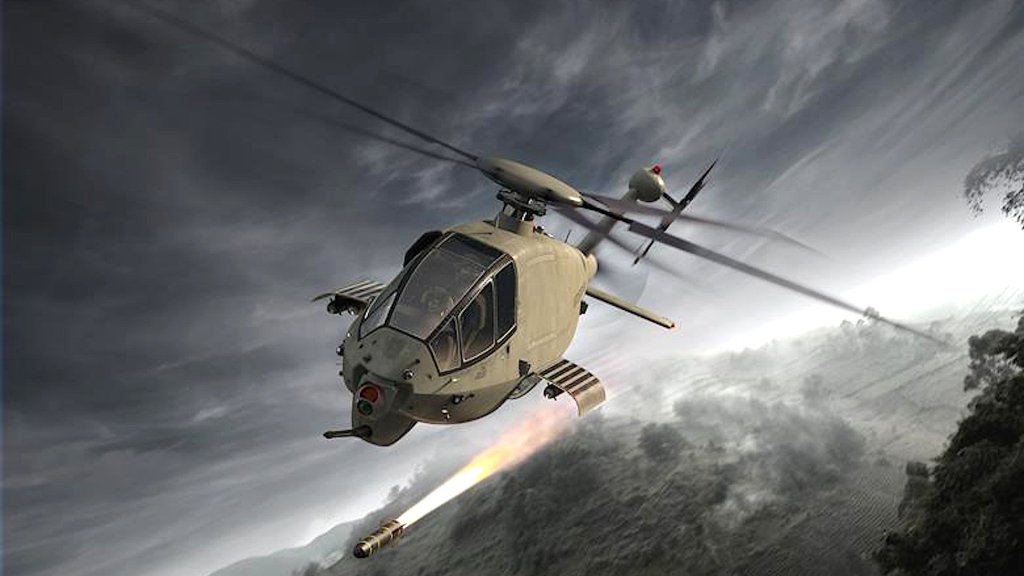
“We’re trying to jump into that [opportunity],” GA-ASI’s Alexander told Breaking Defense in a previous interview when talking about pitching the Gray Eagle STOL as potential a gap-filler in the wake of the FARA program’s cancellation.
“We believe a Gray Eagle STOL would offer the Army new attack reconnaissance capabilities unlike any previous uncrewed system,” GA-ASI’s Brinkley also told The War Zone. “We have already demonstrated Mojave’s ability to operate from austere and rugged dirt roads, to take off and land from a ship at sea, and now to attack targets with machine gun fire.”
Whether or not the Army decides that the new drone would be a good fit for its armed scout and overwatch requirements remains to be seen, especially with lingering concerns about the survivability and, by extension, the utility of non-stealthy medium-altitude armed drones like these. In its favor, like the Gray Eagle in service today, the Gray Eagle STOL can also team with AH-64 Apache attack helicopters, a capability of increasing importance within the Army.
Also now being pitched by GA-ASI is the MQ-9B STOL, which will come in the form of a conversion kit conferring STOL capability on the existing MQ-9B SkyGuardian and SeaGuardian.
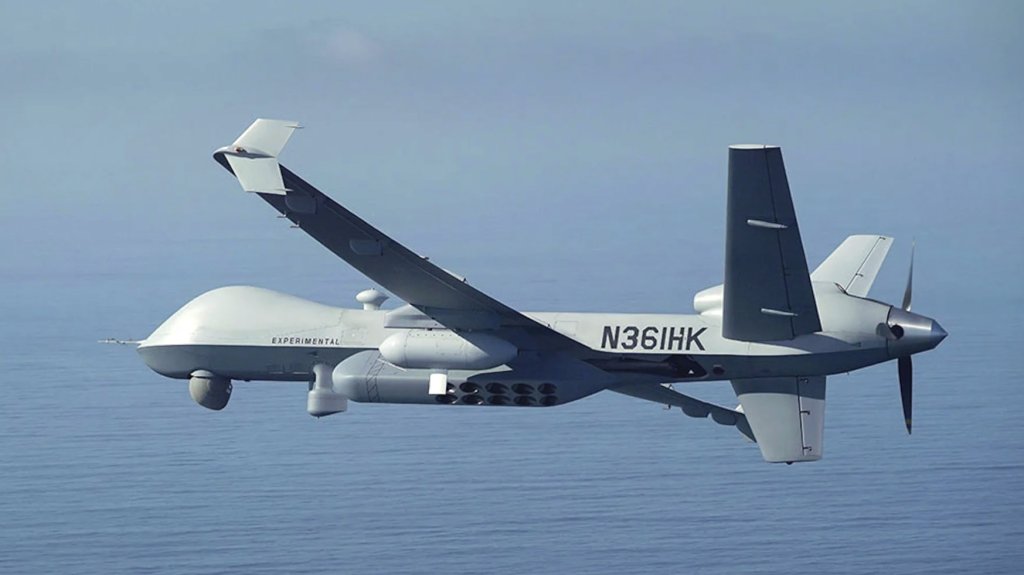
“We are taking the lessons learned from the Mojave prototype and Gray Eagle STOL program to develop MQ-9B STOL,” Brinkley told TWZ. “One airframe, with multiple configurations and mission options. It’s a huge win for MQ-9B customers.”
The MQ-9B STOL is a significantly bigger aircraft than the Gray Eagle 25M/STOL. The MQ-9B has a 38-foot fuselage, 79-foot wingspan, turboprop engine, and maximum takeoff weight of 12,500 pounds. This compares with a 28-foot fuselage, 58-foot wingspan, and maximum takeoff weight of 4,400 pounds for the GE 25M.
At the very least, the Gray Eagle STOL and MQ-9B STOL signal that there remains a lot of potential within the original MQ-1C Gray Eagle and MQ-9B platforms, and GA-ASI is continuing to adapt these aircraft to better suit the future battlefield.
Contact the author: thomas@thewarzone.com
